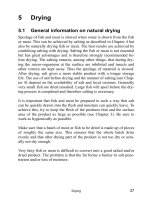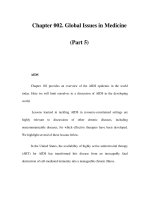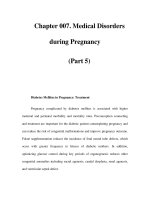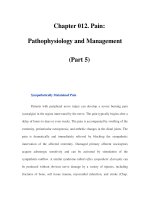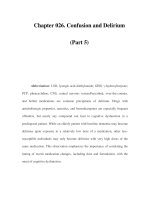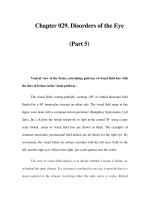Chapter 121. Intraabdominal Infections and Abscesses (Part 5) pps
Bạn đang xem bản rút gọn của tài liệu. Xem và tải ngay bản đầy đủ của tài liệu tại đây (47.73 KB, 5 trang )
Chapter 121. Intraabdominal
Infections and Abscesses
(Part 5)
Intraperitoneal Abscesses
Abscess formation is common in untreated peritonitis if overt gram-
negative sepsis either does not develop or develops but is not fatal. In
experimental models of abscess formation, mixed aerobic and anaerobic
organisms have been implanted intraperitoneally. Without therapy directed at
anaerobes, animals develop intraabdominal abscesses. As in humans, these
experimental abscesses may stud the peritoneal cavity, lie within the omentum or
mesentery, or even develop on the surface of or within viscera such as the liver.
Pathogenesis and Immunity
There is often disagreement about whether an abscess represents a disease
state or a host response. In a sense, it represents both: while an abscess is an
infection in which viable infecting organisms and PMNs are contained in a fibrous
capsule, it is also a process by which the host confines microbes to a limited space,
thereby preventing further spread of infection. In any event, abscesses do cause
significant symptoms, and patients with abscesses can be quite ill. Experimental
work has helped to define both the host cells and the bacterial virulence factors
responsible—most notably, in the case of B. fragilis. This organism, although
accounting for only 0.5% of the normal colonic flora, is the anaerobe most
frequently isolated from intraabdominal infections, is especially prominent in
abscesses, and is the most common anaerobic bloodstream isolate. On clinical
grounds, therefore, B. fragilis appears to be uniquely virulent. Moreover, B.
fragilis acts alone to cause abscesses in animal models of intraabdominal
infection, whereas most other Bacteroides species must act synergistically with a
facultative organism to induce abscess formation.
Of the several virulence factors identified in B. fragilis, one is critical: the
capsular polysaccharide complex (CPC) found on the bacterial surface. The CPC
comprises at least eight distinct surface polysaccharides. Structural analysis of
these polysaccharides has shown an unusual motif of oppositely charged sugars.
Polysaccharides having these zwitterionic characteristics, such as polysaccharide
A (PSA), evoke a host response in the peritoneal cavity that localizes bacteria into
abscesses. B. fragilis and PSA have been found to adhere to primary mesothelial
cells in vitro; this adherence, in turn, stimulates the production of tumor necrosis
factor α (TNF-α) and intercellular adhesion molecule 1 (ICAM-1) by peritoneal
macrophages. Although abscesses characteristically contain PMNs, the process of
abscess induction depends on the stimulation of T lymphocytes by these unique
zwitterionic polysaccharides. The stimulated CD4+ T lymphocytes secrete
leukoattractant cytokines and chemokines. The alternative pathway of complement
and fibrinogen also participate in abscess formation.
While antibodies to the CPC enhance bloodstream clearance of B. fragilis,
CD4+ T cells are critical in immunity to abscesses. When administered
subcutaneously, B. fragilis PSA has immunomodulatory characteristics and
stimulates CD4+ T regulatory cells via an interleukin (IL) 2–dependent
mechanism to produce IL-10. IL-10 downregulates the inflammatory response,
thereby preventing abscess formation.
Clinical Presentation
Of all intraabdominal abscesses, 74% are intraperitoneal or retroperitoneal
and are not visceral. Most intraperitoneal abscesses result from fecal spillage from
a colonic source, such as an inflamed appendix. Abscesses can also arise from
other processes. They usually form within weeks of the development of peritonitis
and may be found in a variety of locations—from omentum to mesentery, pelvis to
psoas muscles, and subphrenic space to a visceral organ such as the liver, where
they may develop either on the surface of the organ or within it. Periappendiceal
and diverticular abscesses occur commonly. Diverticular abscesses are least likely
to rupture. Infections of the female genital tract and pancreatitis are also among
the more common causative events. When abscesses occur in the female genital
tract—either as a primary infection (e.g., tuboovarian abscess) or as an infection
extending into the pelvic cavity or peritoneum—B. fragilis figures prominently
among the organisms isolated. B. fragilis is not found in large numbers in the
normal vaginal flora. For example, it is encountered less commonly in pelvic
inflammatory disease and endometritis without an associated abscess. In
pancreatitis with leakage of damaging pancreatic enzymes, inflammation is
prominent. Therefore, clinical findings such as fever, leukocytosis, and even
abdominal pain do not distinguish pancreatitis itself from complications such as
pancreatic pseudocyst, pancreatic abscess (Chap. 307), or intraabdominal
collections of pus. Especially in cases of necrotizing pancreatitis, in which the
incidence of local pancreatic infection may be as high as 30%, needle aspiration
under CT guidance is performed to sample fluid for culture. Many centers
prescribe preemptive antibiotics for patients with necrotizing pancreatitis.
Imipenem is frequently used for this purpose since it reaches high tissue levels in
the pancreas (although it is not unique in this regard). If needle aspiration yields
infected fluid, most experts agree that surgery is superior to percutaneous
drainage.
